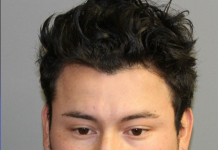Panelists discussed redistricting rules and needed reforms at St. Peter’s University’s Guarini Institute for Government and Leadership yesterday.
By Daniel Ulloa/Hudson County View
Cory Garriga, a community organizer for the Latino Action Network (LAN), and Democracy and Justice Program at the New Jersey Institute for Social Justice Director Henal Patel discussed issues with the redistricting process, which occurs every decade or so after the U.S. Census.
“Poorly drawn districts hurt communities of color and they skewer election results, and they sometimes unfairly advantage one political party over another and they make, well, they make people have less of a voice,” said Guarini Institute Executive Director Ginger Gold Schnitzer, who moderated the panel.
“If the public doesn’t advocate and provide input into redistricting, then politicians are free to use this process to solidify their own power.”
Patel explained that the problem with redistricting is when the lines are changed to in a process whereby “gerrymandering is the strategic manipulation of this process to increase one group’s power at the expense of others.”
She noted a concentrated racial community can be concentrated in one district or spread either in a way that could decrease the influence of the community.
“You deny them the opportunity to have a majority district or to have a genuine influence in any district,” Patel said, continuing that many have taken umbrage with the Jersey City map approved by the Board of Ward Commissioners.
“The public tried to participate in a hearing and it didn’t seem like anyone was listening. And that’s because they’re not required to. They just have to vote on it at a public meeting. There’s no requirement they have to listen to that input. Other states have commissions that do education, public education.”
Patel also highlighted a recent petition that was started in hopes of getting city and state officials to take action, later urging others to sign.
“When they don’t have to listen it becomes a problem. That’s a problem with our process. We need reform with our process,” she said regarding the redistricting process in Hudson County.
Garriga noted that in New Jersey, there are commissions for state legislative and congressional district maps divided equally between Democrats and Republicans who appoint five members each and an 11th neutral tie-breaker who determines which map is used.
As for the state level, the commissioner who is tie-breaking vote is usually more interested in the public’s opinion on a map than the commission’s Democrats and Republicans.
She added that in a national study, public testimony was said to have influenced several redistricting maps.
From there, Garriga further stated that redistricting commissioners are often looking for certain qualifications in district maps such as layout and racial makeup.
“At these public hearings not only can you testify, you can provide a community map,” he added.
Along with the NJ Institute for Social Justice, LAN partnered with the League of Women Voters to draw an alternative congressional map.
“We released a map and we called it the Fair Districts Coalition map and it basically depicted racial equity throughout the state based off of data,” he said.
Garriga noted he organized people to testify in favor of their map.
“Does it matter or is it really a done deal?,” Schnitzer asked regarding testifying on the redistricting process.
“Part of the problem is our system. There is a little bit of a requirement for public participation in the congressional one. The state legislative one, they’re not required to do any,” Patel responded.
On issues with race in redistricting, Patel noted Montclair has been divided by congressional district for some time, with the township’s Black neighborhood being part of the 10th Congressional District and the white communities in the 11th.
“The Black community was like no. They said if you’re going to unite us, ok, but you have to do it in the majority Black district. It’s important for us to stay in a majority Black district. Our interests are better served in this district,” she recounted.
She noted the Fair Districts Coalition wrote a bill to amend the state legislative redistricting process but no member of the legislature will sponsor it.
“Who wants to be the one who says we’re going to give up power or upset party leadership?” Patel asked.
Garriga noted the ideal in the redistricting process is for the districts to be relatively the same in terms of racial makeup. Congressional districts are supposed to contain around 750,000 people.
“New Jersey has a history in these maps of over representing white communities,” Patel asserted.
She said the New Jersey congressional map currently has one majority-Black district, one majority Hispanic district (which contains Hudson), and one district that was a minority-majority district.
The other 10 were mostly white, even though minorities make up 40 percent of the population.
Disclosure: Daniel Ulloa is on the Latino Action Network board.








